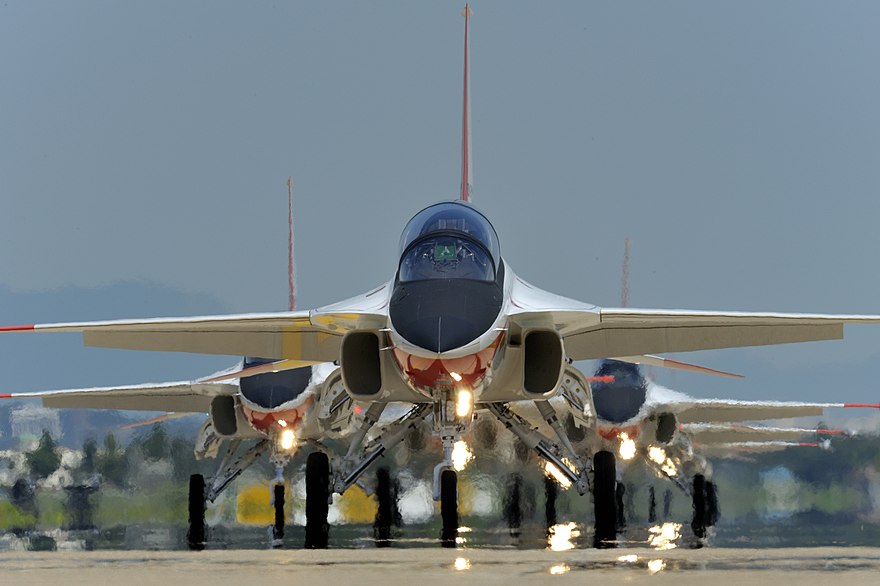Lockheed Martin is betting heavily on the ‘N’ variant of the T-50 advanced jet trainer (TF-50N) to train pilots on fourth and fifth-generation fighters that will operate from aircraft carriers.
The ‘N’ variant is the US Navy’s Tactical Surrogate Aircraft (TSA) program. The aim is to have a fleet of leading and supplementary training aircraft for new pilots. It will also be used for tactical drilling and experimentation purposes.
Possessing technologies of the F-16 and the F-35, according to co-developer Lockheed Martin — the other being the Korea Aerospace Industries (KAI) — the T-50, in general, has seen rapid development in both its trainer and combat versions.
Lockheed Martin appears to be hoping to capitalize on the T-50’s slew of international successes and secure the USN’s Tactical Surrogate Aircraft program by pitching the TF-50N, a naval variant.
Lockheed’s Push
In a recent promotional video, Lockheed’s test pilot Tony “Brick” Wilson claimed that the TF-50N would train student pilots in both the “tactical training arena” and “shipboard operations in their 4th and 5th gen fighters.”

The company is now incorporating “live virtual constructive training” and “augmented reality” while integrating them with the TF-50N’s mission system suite and future upgrade-friendly design to drill both “air-to-surface” and “air-to-air” scenarios. An Auto Ground Collision Avoidance System will be assimilated into the TF-50N to cater to accident-prone pilot training scenarios.
Lockheed added on its website that the TF-50N drew “engineering and design elements from the F-16 and the F-35.”
This will include the airframe design from the F-16 and the avionics and cockpit layout from the F-35. “The active production line in South Korea is supported by an extended global supplier network and conducts full value stream production. A Final Assembly and Check-Out (FACO) facility can be quickly activated when and where needed,” Lockheed added.
Rejected But Still Used By US Air Force
The T-50A, the basic advanced jet trainer variant, was originally a contender for the US Air Force’s T-X program but lost the competition in September 2018 when the USAF selected Boeing-Saab’s T-7 Redhawk. USAF was, at that time, seeking new jet trainers to replace the aging T-38C pilot training jets.
Interestingly, in March 2020, the USAF sought to lease four to eight T-50A trainers due to manufacturing delays with the T-7. This was a rare occasion when a service ended up using the platform of a losing bidder.
More Operators
The loss in the USAF procurement did not seal the T-50A’s fate, as it later saw stellar success elsewhere. Presently, more than 250 T-50 aircraft are operating and on order across quite a few aerobatic, training, and combat variants, including the T-50B, TA-50, and FA-40.
The TF-50 is ready to prepare today's aviators for tomorrow’s challenges. Learn how it addresses @usnavy training needs from test pilot and former naval aviator, Tony “Brick” Wilson.
Learn more about the TF-50: https://t.co/LVEf7TE6Lg pic.twitter.com/z0UwLBAnOX
— Lockheed Martin (@LockheedMartin) April 10, 2024
The operators include the US, Iraq, Indonesia, Philippines, and Thailand (South Korea is also there) while formal delivery contracts have been signed with the Malaysian and Polish air forces.
Of these, Thailand, Iraq, and Indonesia are using sub-variants of the T-50 trainer version, while Malaysia, the Philippines, and Poland operate the FA-50 light fighter/attack version. The Republic of Korea Air Force (RoKAF), meanwhile, operates both the T-50 and the FA-50, with the largest fleet of nearly 120 jets.
The T-7A Redhawk, however, does not have any international users outside the USAF as yet, with the jet being pitched to the Royal Australian Air Force (RAAF), Serbian Air Force, Brazilian Air Force, and the Japanese Air Self-Defense Force (JASDF).
The jet is also quickly evolving into a capable light ground attack and fighter jet and a lead-in fighter trainer (LIFT), competing directly with India’s LCA Tejas.
Recent reports said that KAI has planned a single-seat multirole-fighter variant. This will allow either/or additional fuel or advanced electronics while also being cheaper than the original twin tandem seat configuration.
US Navy’s Tactical Surrogate Aircraft Program
The Tactical Surrogate Aircraft (TSA) program has not seen any movement since the Sources Sought notice (Sources Sought is not an actual bid or proposal solicitation; instead, it’s a solicitation of interest) that was published in October 2021. At that time, the US Navy was considering purchasing 64 jets, with a formal program to be launched in 2024 or 2025.
The TSA would have three purposes. First, as a “companion trainer,” where newly graduated naval aviators who have progressed to frontline aircraft can continue additional flight training without having to stress the airframe and spend time on high-end jets. These include leading planes like the F/A-18 Super Hornet or the F-35C.
The TSA program also mentioned that it should “simulate and/or replicate current and future fighter aircraft systems.” This involves serving as “red air” platforms to serve in the Navy’s in-house Aggressor Squadrons. Red teaming in the military involves units imitating the enemy forces in wargames and training exercises while others perform the role of their own friendlies, called “blue teams.”
The USAF and USN have dedicated aggressor squadrons flying F-35 and F-16 jets, along with services offered by private contractors, that replicate a variety of adversary aircraft, tactics, and technology based on information received from the intelligence community.
Lastly, according to The War Zone, the Navy envisages its Tactical Surrogate Aircraft serving as “a flight lead aircraft for Fleet Replacement Squadrons.” These squadrons are the operational training units for the Navy’s frontline force in the tactical community.
Their job includes carrier-qualified new pilots for specific aircraft types, as well as other critical tactical aspects of the assigned mission. The flight lead aircraft is the one flown by the flight leader in a multi-aircraft formation. The role envisages a jet that will be used as part of the training process for future fighter pilots within the relevant Fleet Replacement Squadrons.
- The author can be reached at satamp@gmail.com
- Follow EurAsian Times on Google News